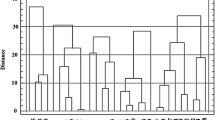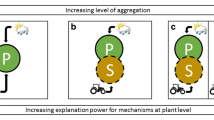Abstract
Broad genotypic variation in the response to low soilmoisture and reduced nitrogen supply was found amongthe wild Hordeum spontaneum accessions and thelandraces and modern cultivars of H. vulgare ofdifferent geographic origin. Measurements at the endof vegetative growth in plants grown in soil culturesrevealed genotypically specific responses to the usedenvironmental factors. Cultivars and breeding linesfrom Syria and Ethiopian landraces combined bothdrought resistance and tolerance to low nitrogen. TheSyrian barleys were also distinguished by a highnitrogen utilization efficiency (NUE) under low Nnutrition. European cultivars indicated a pooradaptation to N shortage, but some of them wereresistant to soil drought. No stress resistant barleyswere found among the wild accessions and Sardinianlandraces. Genotypic differences in the relativevalues of NUE and water use efficiency were associatedwith low N-tolerance. Some Syrian selections,Ethiopian landraces and the modern German cv. Maresiwere found to be most drought resistant. Maintenanceof a relatively high photosynthetic activity of theuppermost leaves was associated with droughtresistance. As far as concerning with the vegetativegrowth phase, the modern Syrian germplasm andEthiopian landraces may be recommended as donors ofadaptative characters for local barley breeding.
Similar content being viewed by others
References
Arnau, G. & P. Monneveux, 1995. Physiology and genetics of terminal water stress tolerance in barley. J Genet & Breed 49: 327-332.
Attene G., S. Ceccarelli & R. Papa, 1996. The barley (Hordeum vulgare L.) of Sardinia, Italy. Genetic Resources and Crop Evolution 43/5: 385-393.
Austin, R.B., 1989. Prospects for improving crop production in stressful environments. In: H.G. Jones et al. (Eds.), Plants under Stress, pp. 235-248, Soc. Exp. Biol. Seminar Ser. 39, Cambridge Univ. Press.
Blum, A., 1987. Methods of plant breeding for drought resistance. In: Monti L. & Proceddu E. (Eds.), Agriculture. Drought Resistance in Plants. Physiological and Genetic Aspects, pp. 235-254, Euro. Comm. EAEC, Brussels.
Ceccarelli, S., 1996. Adaptation to low/high input conditions. Euphytica 92: 203-214.
Ceccarelli, S. & S. Grando, 1991. Environment of selection and type of germplasm in barley breeding for low-yielding conditions. Euphytica 57: 207-219.
Ceccarelli, S. & S. Grando, 1996. Drought as a chalenge for the plant breeder. Plant Growth Regulation 20: 149-155.
El Bassam, N., M. Dambroth & B.C. Loughman, 1990. Genetic Aspects of Plant Mineral Nutrition. Kluwer Acad. Publ., Dordrecht.
Fathi, G., G.K. McDonald & R.C.M. Lance, 1997. Effects of postanthesis water stress on the yield and grain protein concentration of barley grown at two levels of nitrogen. Aust J Agric Res 48: 67-80.
Fischer, R.A. & R. Maurer, 1978. Drought resistance in spring wheat cultivars. I. Grain yield responses. Austr J Agric Res 14: 897-912.
Giles, B.E. & R. von Bothmer, 1985. The progenitor of barley (Hordeum vulgare ssp. spontaneum) — its importance as a gene resource. Sved Utsaedes Tidskr 95: 53-61.
Górny, A.G., 1993. Differences in root and shoot response to limited N-supply in oat and spring barley. J Agronomy & Crop Science 171: 161-167.
Górny, A.G., 1994. Genotypic variation in root development and its associations with nitrogen and phosphorus use efficiency in spring barley under high and reduced nutrition. Genetica Polonica 35B: 293-298.
Grando, S. & S. Ceccarelli, 1991. Use of H. vulgare ssp. spontaneum in barley breeding for stress conditions. In: L. Munck (Ed.), Barley Genetics VI, v. I, pp. 526-529. Proc. 6th Inter. Barley Genet. Symp., Helsinborg.
Grando, S. & S. Ceccarelli, 1995. Seminal root morphology and coleoptile length in wild (Hordeum vulgare ssp. spontaneum) and cultivated (Hordeum vulgare ssp. vulgare) barley. Euphytica 86: 73-80.
Johnson, R.R. & D.N. Moss, 1976. Effect of water stress on 14CO2 fixation and translocation in wheat during grain filling. Crop Sci 14: 728-731.
Jorna, M.L. & L.A.J. Slootmaker, 1988. Cereal Breeding Related to Integrated Cereal Production. Pudoc, Wageningen.
Palta, J.A., T. Kobata, N.C. Turner & I.R. Fillery, 1994. Remobilization of carbon and nitrogen in wheat as influenced by postanthesis water deficits. Crop Sci 34: 118-124.
Papa, R., 1994. Response to salinity of barley (Hordeum vulgare L.) genotypes extracted from a local population. J of Genetics & Breeding 48(1): 99-102.
Passioura, J.B., 1982. The role of root system characteristics in the drought resistance of crop plants. In: Drought Resistance in Crops with Emphasis on Rice, IRRI (Ed.), Los Banos, 72-82.
Peltonen-Sainio, P. & P. Mäkelä, 1995. Comparison of physiological methods to assess drought tolerance in oats. Acta Agric Scand, Sect B, Soil and Plant Sci 45: 32-38.
Richards, R.A., 1996. Defining selection criteria to improve yield under drought. Plant Growth Regulation 20: 157-166.
Sarič, M.R. & B.C. Loughman, 1983. Genetic Aspects of Plant Mineral Nutrition. Martinus Nijhoff/Dr W. Junk Publ., The Hague.
Sattelmacher, B., W.J. Horst & H.C. Becker, 1994. Factors that contribute to genetic variation for nutrient efficiency of crop plants. Z Pflanzenernähr Bodenk 157: 215-224.
Siddiqi, M.Y. & A.D.M. Glass, 1981. Utilization index: a modified approach to the estimation and comparison of nutrient utilization efficiency in plants. J Plant Nutr 4: 289-302.
Veteläinen, M., E. Nissilä, P.M.A. Tigerstedt & R. von Bothmer, 1996. Utilization of exotic germplasm in Nordic barley breeding and its consequences for adaptation. Euphytica 92: 267-273.
Woodend, J.J. & A.D.M. Glass, 1993. Genotype-environment interaction and correlation between vegetative and grain production measures of potassium use efficiency in wheat (T. aestivum L.) grown under potassium stress. Plant and Soil 151: 39-44.
Author information
Authors and Affiliations
Rights and permissions
About this article
Cite this article
Górny, A.G. Variation in utilization efficiency and tolerance to reduced water and nitrogen supply among wild and cultivated barleys. Euphytica 117, 59–66 (2001). https://doi.org/10.1023/A:1004061709964
Issue Date:
DOI: https://doi.org/10.1023/A:1004061709964




